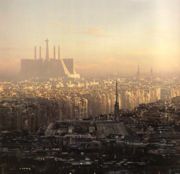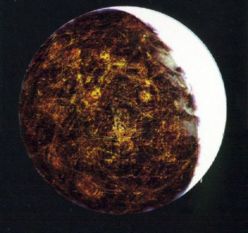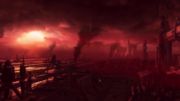|
|
Coruscant
From TheHolo.Net Forums Wiki

Name
Imperial Center (Coruscant)
Moons
3: Centax-1; Centax-2; Centax-3
Primary Terrain
Planetary cityscape, mountains
Points of Interest
Central Gathering Hall, Galactic Museum, Galaxies Opera House, Imperial Palace, Monument Plaza, Senate Building, University of Coruscant, Holographic Zoo of Extinct Animals.
Native Species
Zhell; Taung; Cthon, possibly Human
Population
Over 1 Trillion
The Galactic Center of Coruscant (pronounced /'kʊɹəsɑnt/) was the political hub of the galaxy for millennia. It was generally agreed that Coruscant was, during most of Galactic history, the most politically important world in the galaxy. A large number of the galaxy's trade routes—including the Perlemian Trade Route, the Corellian Run, the Metellos Trade Route, the Koros Trunk Line, and the Leisure Corridor—went through Coruscant, making it one of the richest worlds in the galaxy. Tellingly, the planet's hyperspace coordinates were (0,0,0), and the military designation was Triple Zero.
The actual planet-wide city of Coruscant was known as Galactic City, Republic City, Coruscant City or the City of Spires under the Galactic Republic and as Imperial City during the rule of the Galactic Empire.
|
Planetary Features
|
- "Seen from orbit, Imperial Center is a blaze of light and sparkling colors, reminding some spacers of corusca stones, after which this planet was named long ago."
- ―Pollux Hax
Surface
Geologically, the planet comprised a molten core with rocky mantle and silicate rock crust.
The entire surface of Coruscant was covered over throughout the thousands of generations of galactic history by sprawling mile-high skyscrapers and cities, and boasting a population of over a hundred billion to several trillion, depending on the era. These skyscrapers dwarfed all the original natural features, including mountains, as well as floors of oceans which once covered a large proportion of Coruscant's surface. Areas of Galactic City were broken up into levels, megablocks, blocks, and subblocks. Coruscant itself was divided into quadrants, which were divided into zones. Below the skyscrapers was Coruscant's Underworld/undercity, where sunlight never reached. Artificial lighting illuminated these lower levels and advertisement holograms could be seen everywhere. There were numerous establishments for entertainment, catering to a myriad of alien species.
 Overlooking the Senate District at night, c. 19 BBY. Coruscant was once a world mostly covered in oceans. However, all natural bodies of water were drained and stored in vast caverns beneath the city as a result of years of overpopulation. The only body of water visible was the artificial Western Sea, with many artificially-created islands floating on it, used by tourists on holidays.
With no bodies of water available to feed and water its trillion inhabitants, Coruscant's architects, along with many others from around the galaxy, worked together to build a self-contained eco-system in the massive buildings set all over the planet. Polar cap stations also melted ice and distributed water throughout the planetwide city through a complex series of pipes.
Mountains
One of the few pieces of Coruscant's landmass that were left untouched were the Manarai Mountains, twin peaks that stuck up out of the ground near the famous Imperial Palace. The Manarai Mountains included the tallest peak, Umate; many floating restaurants; the Monument Plaza; and were home to the Flames of Umate cult.
|
|
|
Neighborhoods
|
| Galactic City was divided into quadrants, "several thousand" in number, with each quadrant further split into sectors. Each sector was numbered on official maps, but sectors often had nicknames, such as Sah'c Town (sector H-46, named for a prominent family that owned a large portion of its land) and The Works, the largest of Coruscant's designated industrial zones.
Coruscant practiced zoning, which is the designation of specific areas of land for particular purposes, such as governmental and senatorial, financial (including banking zones), residential, commercial, industrial, and manufacturing. Manufacturing and industrial zones were typically the largest designated areas of the planet.
The Works was once one of the Galaxy's major manufacturing areas, where spacecraft parts, droids, and building materials were heavily produced for centuries, but as construction and industry became more efficient and cheaper away from Coruscant, The Works fell in disrepair. It gained the reputation as a hub of high criminal activity and many locals stayed away from it.
Another area of Coruscant was CoCo Town (short for "collective commerce"). Many diverse species lived there and worked in manufacturing. A partially enclosed open-air plaza near the Senate building was called Column Commons because it housed most of the HoloNet and news media corporations.
Most infamous of all was the Alien Protection Zone, colloquially known as the Invisible Sector or Invisec for short, was a walled off ethnic neighborhood on Imperial Center. A neighborhood supposedly built for non-Human species to protect them from "genuine prejudice", the Galactic Empire was in essence segregating them from the human population. This practice is in line with the Empire's undeniable Humanocentric policies.
Conditions inside Invisec were very poor and residents were often harassed by Stormtroopers. Propaganda reports indicate that neighborhoods were built to reflect the various different cultures of the galaxy's alien species, though this may have been untrue. However, it is true that alien neighborhoods were dominated by statues to honor heroes from their respective homeworlds. This tactic was used to make alien residents feel as if the ethnic neighborhoods were really meant to be a place of honor and hope, which they were not.
|
|
Livability
|
 The many layers of the city. Almost everything on the planet, from clothes to packaging and machinery, was recyclable. Another problem for a world like Coruscant was the unimaginable amount of carbon dioxide and heat energy that its trillion-being population generated each day, so thousands of carbon dioxide-reactive atmospheric dampeners were put into place in the upper atmosphere to prevent atmospheric degeneration. The first set of these planet-wide dampeners, developed by the Galactic Republic, was known as the Coruscant Atmospheric Reclamation Project.
Near the planet's core were a number of massive power relay stations. The lowest levels were abandoned to mutants and scavengers, such as the cannibalistic, mythical Cthons. The foundations of many of the buildings, some of which weighed billions of tons, also extended deep into the planet's crust.
Galactic Standard Time was developed on Coruscant and revolved around the hours Coruscant had in a single day, which was 24 hours, with 368 local days a year.
|
|
History
|
Pre-Republic
The very early history of Coruscant is a bit sketchy and is not well known. Coruscant was considered by many to be the Human homeworld. Millennia ago, the Architects could have removed Humans from Coruscant with which to populate Corellia.
Around 200,000 BBY, the near-Human Taungs attempted to conquer the 13 baseline Human nations of the Battalions of Zhell. A volcano decimated the Zhell, the ash filling the skies for two years, so the Taungs adopted the name Dha Werda Verda (Warriors of Shadow) for themselves. The Human Zhell eventually recovered and drove the Taungs offworld - the Taungs fled to Roon.
One hundred millennia later, Coruscant was surveyed by the Columi, who dismissed the planet as a primitive disappointment, despite the already planet-spanning ecumenopolis of Galactic City. New buildings were built on the old. As a result, there was virtually no exposed land. In the forgotten underlevels of the city, there was darkness, pollution and crime. Higher up, there were government offices and penthouses owned by the elite. The lower fifty levels of the ecumenopolis is said to have last seen sunlight around 95,000 BBY.
Coruscant was one of many worlds conquered by the Infinite Empire of the Rakata, who used Human slaves to build the Star Forge in 30,000 BBY. Under Rakatan domination, the Humans of Coruscant's colonization attempts were limited to sleeper ships, which ended up on Alderaan, in the Tion Cluster, Seoul 5, Kuat, Alsakan, Axum, Anaxes, Atrisia, Metellos, Corulag, and many other worlds. The Rakata were eventually decimated by a massive plague, leading to slave revolutions on Coruscant and other subjected worlds.
Over the next two centuries, Coruscant was linked to other Core Worlds, including Corellia and Duro, by hyperspace cannons. It was during this time that the Coruscant government peacefully absorbed the nearby Azure Imperium. During these pre-Republic years, the languages of Coruscant and its neighbors meshed to become Old Galactic Standard.
Early Republic
 Galactic City c. 5,000 BBY. In 25,000 BBY, the Corellians and Duros invented the hyperdrive proper, allowing Coruscant to become the capital of a democratic union - the Galactic Republic. The planet remained the Republic's capital for twenty five thousand years. Shortly after the formation of the Republic, the Perlemian Trade Route was mapped, linking Coruscant to Ossus and bringing the Jedi Knights into the Republic. Over the next millennium, the Corellian Run was mapped, linking Coruscant to Corellia and beyond. Blasters were also invented on Coruscant around this time, and the famous Galactic Museum was constructed in 12,000 BBY.
From the very beginning, Coruscant, as the Republic's capital, was the primary objective in several wars. The earliest among these was the Tionese War with the Honorable Union of Desevro and Tion in 24,000 BBY, in which Coruscant was bombarded with Tionese pressure bombs. Other early battles included the Alsakan Conflicts, the Duinuogwuin Contention, the Great Hyperspace War, the Third Great Schism, the Great Droid Revolution, and the Great Sith War.
Following the devastation of Ossus, the Jedi Council took up residence in the Jedi Temple on Coruscant, to which many Jedi relics from Ossus were taken. The Temple was greatly expanded, including the building of the original Jedi Council Chamber. The Temple was repeatedly expanded including in 3,519 BBY, 2,519 BBY (when the Jedi Archives were built), 2,019 BBY, and 1,000 BBY (when the Temple spires were built).
In 2,973 BBY, the Senate Rotunda was founded, replacing the previous assembly place.
End of the Republic
As Darth Sidious gained in power (and made Anakin Skywalker Darth Vader in the process), and other major politicians and entities became more aggressive, political instability surged both in the Galaxy and on Coruscant, threatening Coruscant itself and inflicting much violence on and near Coruscant.
In 27 BBY, Coruscant was almost destroyed by Ashaar Khorda using the Infant of Shaa. Jango Fett, Zam Wesell, and Yarael Poof saved Coruscant, although Poof sacrificed himself to do so.
In 23 BBY, near the end of the Separatist Crisis, the Confederacy of Independent Systems began to become a significant threat against the Republic, causing several systems to secede, including Ando and Sy Myrth, resulting in a mass exodus of Aqualish and Sy Myrthians from Coruscant.
 The Jedi Temple on Coruscant at sunset. During these times, several assassination attempts were made on Padmé Amidala while she was on Coruscant, including one where her personal ship was destroyed and several of her handmaidens killed. Anakin Skywalker and Obi-Wan Kenobi were assigned to protect her. Eventually, they managed to foil an attempt at Padmé's penthouse by Zam Wesell, resulting in an airspeeder chase through Coruscant, ending in a showdown at the Outlander Club in the lower levels. The Jedi caught Zam, but she was killed by a mysterious armored figure, leading Obi-Wan to Kamino.
During most of the Clone Wars, Coruscant was subject to frequent Separatist terrorist acts and assassinations of leading Republic figures. These included the holding of Senator Meena Tills hostage by Korunnai terrorists in 22 BBY (actually cover for an attempt to turn the Corporate Sector against the Republic). 21 BBY saw a wave of such disasters, including the Coruscant Insurrection and the assassinations of Finis Valorum and Senator Viento.
Such incidents prompted the Republic to implement numerous changes on Coruscant in the name of increased security. Huge stretches of the cityscape were transformed into military staging areas, and clone troopers were seen everywhere. The fanatical pro-Human COMPOR was founded, the local SAGroup led by Nenevanth Tion marching in a patriotism parade. COMPOR pressured Tannon Praji into deporting from the capital all members of species whose homeworld had joined the Confederacy. Vice-Admiral Terrinald Screed was placed in charge of Coruscant Planetary Defense.
Yet in 19 BBY, the Confederacy of Independent Systems succeeded in making a raid on Coruscant. Using secret hyperspace routes through the Deep Core provided by Darth Sidious, a Separatist fleet under the command of the dreaded General Grievous made a raid on the city planet. While the Separatist fleet engaged the Republic fleet, an army of battle droids landed on Galactic City. The invasion distracted the defending Jedi and clone forces while General Grievous and a squad of his elite MagnaGuards captured the Supreme Chancellor Palpatine. However, Anakin Skywalker and Obi-Wan Kenobi succeeded in rescuing the Supreme Chancellor from the infamous Separatist flagship Invisible Hand. The Battle of Coruscant eventually turned to the Republic's favor and the Separatist's armada was forced into a full retreat.
However, the battle had shaken much of the population, and large portions of the city had been decimated by falling ships or collateral damage caused in the vicious fighting.
Near the end of the Clone Wars, Coruscant was transformed into Imperial Center following Chancellor Palpatine's Declaration of a New Order, reorganizing the Galactic Republic into the Galactic Empire.
Galactic Empire
 The skyscrapers of Coruscant. While the planet's name was officially changed during Palpatine's rule, most denizens of the Empire continued to call the planet-city by its old name. As part of the Humanocentric policies of the galaxy, nonhuman species were also compelled to live in segregated parts (also known as "ethnic neighborhoods") of Imperial City, such as Invisec. Those that did enter other parts, whether by intention or mistake, were punished brutally.
During Imperial times, a proclamation by Palpatine made Imperial Center the only planet in the galaxy where political science students could do postgraduate work. The reason was twofold: foremost was the hope that the future politicians and technocrats of the galaxy would be more likely to accept the values and rule of the New Order; second was that the brightest of them could be detained, either voluntarily or by force, on Center to assist in the running of the Empire.
Emperor Palpatine also began to shape Coruscant with his own designs, and this included the installment of thousands of surveillance systems throughout the ecumenopolis. Massive shield generators were placed all over Coruscant, and where they overlapped, powerful storms took place, giving the planet a gothic look, which mirrored the utter desperation of many of its inhabitants as they choked under Palpatine's iron rule.
The Emperor also had the Palace of the Republic rebuilt and renamed the Imperial Palace. The Imperial Palace was a massive pyramidal structure and was the largest construction project in Coruscant. Other distinctive structures of the Galactic Republic, such as the Galactic Senate and the Jedi Temple, were either destroyed or eclipsed by newer buildings.
| |
|
|
Citizens of Coruscant on SW-Fans
|
| These are the currently known citizens of Imperial Center (with species, gender, occupation and location where known):
Criminal Organisations Members:
- Sasseeri Reeouurra - Cizerack female, Leader of Black Sun (Tapes District)
- Kal Olorin - Human male, Vigo for Black Sun
- Ynara Chukk - Human female, Lawyer & Black Sun lackey
- Varla - Human female, Courtesan & Lieutenant of Black Nebula
- Mato - Human male, Sub-Lieutenant & Enforcer for Black Nebula (Chiba District)
- Kalail Rotas - Human female, Accountant at the Kasajian Exchange & Lieutenant of Black Nebula
- Xel-Naga - Human male, Enforcer for Black Nebula
Law Enforcement Agents:
Imperials:
- R.S. Esalis - Human female, Director of Imperial Intelligence
- Jekaan Oludh - Human male, Intel agent
- Qourr Mhawat - Human female, Intel agent
- Danni Reyok - Human female, Sergeant (?)
- Karl Valten - Human male, Grand Inquisitor
- Rossos Atrapes - Human male, Inquisitor
- Y'roth Helghast - Human male, Inquisitor
- Victor Crestmere - NPC, Human male, Inquisitor
- Naomi Lang - Human female, Inquisitor
- Ylor Jerrard - Human male, Inquisitor
- Bren'lar Scothis - Human male, Inquisitor
- Morewind - Human male, Inquisitor
- Dr. Jefsran Ollisen - Human male, Leading medical researcher / practitioner of the Empire (see also Ilias Nytrau)
Rebels:
- Estelle Russard - Human female, deep-cover Rebel agent & Student at the Tarkin Institute of Art and Technology
- Aurelias Kazaar - Human male, Undercover Rebel spy & semi-retired bounty hunter
- Byl Laprovik - Human male, Rebel agent
- Eluna Thals - Human-Replica droid, Rebel agent
Ordinary Citizens:
- Ilias Nytrau - Human male, Jedi in hiding (see also Dr. Jefsran Ollisen)
- Taman Danar - Human female, Office Clerk at the Imperial Treasury Audit Division
- Ariesa d'Veldrin - Human female, teenager
- Marava'shak - Twi'lek female, Housewife
- Lon'shak - Twi'lek male, Clan Elder of the local Shak Clan, Junior Engineer for Corellidyne Holographics
- Teol Na Sareesh - Twi'lek male, independent trader of exotic wares
- Koyi Doneeta - Twi'lek female, formerly dancer, now slave to a local Hutt
- Lhira Doneeta - Twi'lek female, dancer
- Jeny'kyn - Twi'lek female, socialite
- Jason 'The Younger' Russard - Billionaire Industrialist heavily involved with the Inquisitors
- Jason 'The Elder' Russard - The former head of Russard Industries and patriarch of the Russards on Coruscant. Does not completely share his son's opinion of the Empire.
|
|
|









